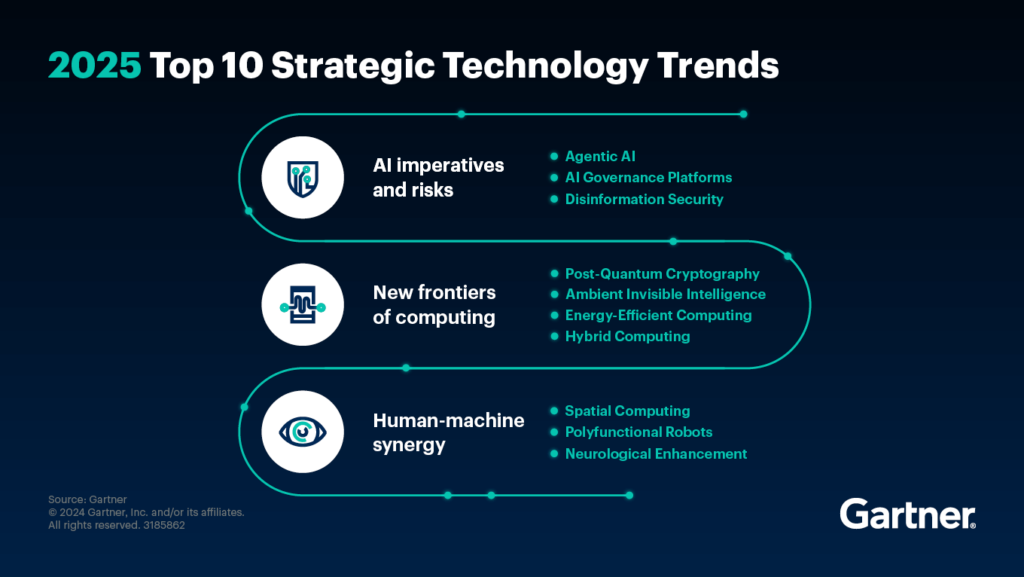Gartner’s annual technology trend report offers a strategic lens to view the future. By identifying emerging technologies and their potential impact, organizations can make informed decisions to drive innovation, improve efficiency, and maintain a competitive edge.
In its latest report, Top Strategic Technology Trends 2025, Gartner highlights three overarching themes, under which next year’s top 10 tech trends fall:
- Agentic AI
Advanced AI systems capable of independently formulating and executing strategies to fulfill user-specified goals.
- Business Value: A versatile AI workforce to assist with various tasks, reduce workload, and complement existing applications.
- Potential Challenge: Developing robust control mechanisms to ensure AI behaviors remain aligned with provider and user values.
- AI Governance Platforms
Advanced technology solutions designed to oversee the legal, ethical, and operational aspects of AI systems.
- Business Value: Enabling organizations to develop and enforce robust AI policies, explain AI decision-making processes, manage the AI lifecycle, and provide transparency to stakeholders.
- Potential Challenge: Navigating the evolving and fragmented regulatory landscape for AI, which varies across different regions and industries.
- Disinformation Security
A specialized technology category focused on systematically assessing and verifying digital trust.
- Business Value: Enhancing fraud prevention measures through robust identity verification, implementing continuous risk assessment and adaptive trust models to deter account takeovers, and safeguarding brand reputation by identifying and neutralizing harmful narratives.
- Potential Challenge: Necessitating a multifaceted, adaptive, and collaborative approach to counter the evolving tactics of digital adversaries.
- Post-Quantum Cryptography (PQC)
Advanced cryptographic techniques designed to withstand the power of quantum computing.
- Business Value: Protecting critical data assets from the emerging quantum computing threat landscape.
- Potential Challenge: Implementing PQC involves significant technical challenges, including potential performance overhead and the need for extensive testing and validation.
- Ambient Invisible Intelligence
Technology discreetly embedded within the environment to facilitate more natural and intuitive human-computer interactions.
- Business Value: Enabling cost-effective, real-time monitoring and tracking of objects, improving operational efficiency and supply chain transparency; facilitating the creation of unforgeable digital identities for objects, enabling them to autonomously report their provenance, history, and properties.
- Potential Challenge: Addressing potential privacy concerns and obtaining necessary user consent for data collection and usage. Users may choose to disable tracking tags to protect their privacy.
- Energy-Efficient Computing
A comprehensive approach to optimizing computing systems for energy efficiency, encompassing hardware, software, and infrastructure.
- Business Value: Mitigating the environmental impact of computing operations and complying with evolving sustainability regulations.
- Potential Challenges: Requiring substantial investments in new hardware, software, and skills, as well as complex migration processes and potential short-term energy cost increases.
- Hybrid Computing
A paradigm that leverages a combination of computing, storage, and networking technologies to address complex computational challenges.
- Business Value: Enabling the creation of highly efficient, high-performance computing environments, advancing the frontiers of AI, powering autonomous systems, and augmenting human capabilities through real-time personalization and human-computer interfaces.
- Potential Challenge: Requiring specialized expertise, posing significant security risks, involving experimental technologies, and necessitating robust orchestration and integration.
- Spatial Computing
A technology model that overlays digital information onto the physical world, enabling immersive and interactive experiences through augmented and virtual reality.
- Business Value: Addressing the growing consumer demand for immersive experiences in gaming, education, and e-commerce, while also providing sophisticated visualization tools for decision-making and efficiency in healthcare, retail, and manufacturing.
- Potential Challenge: Current hardware limitations, such as the bulkiness and inconvenience of head-mounted displays, complex user interfaces, and significant privacy and security concerns.
- Polyfunctional Robots
Multi-task robots capable of adapting to diverse operational requirements.
- Business Value: Significant improvements in operational efficiency, accelerated return on investment, and streamlined deployment processes.
- Potential Challenge: The absence of industry-wide standards for pricing and minimum functionality.
- Neurological Enhancement
Leveraging brain-computer interfaces to enhance cognitive abilities and performance.
- Business Value: Enabling human upskilling, improving workplace safety, personalizing education, extending workforce longevity, and pioneering new marketing strategies.
- Potential Challenge: High costs, limited device capabilities, invasive procedures, security vulnerabilities, and ethical concerns related to potential alterations of human perception and consciousness.
